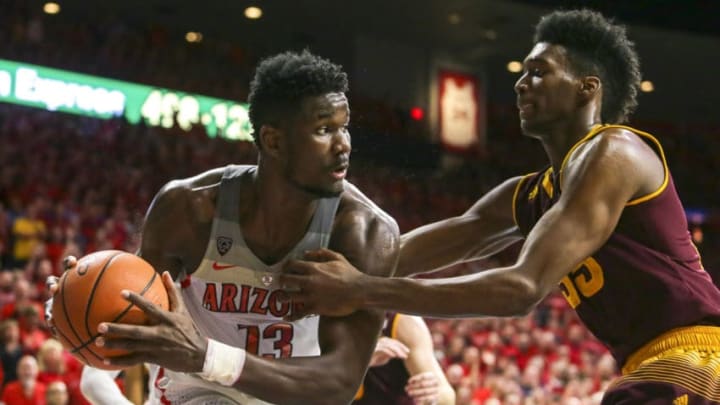While he’s played most of his freshman year at power forward, it’s hard to envision DeAndre Ayton becoming his best possible self playing at the 4.
When the college season started, one thing became apparent: DeAndre Ayton was going to play power forward. Dusan Ristic has gotten the look at center for Arizona. Experience is important in college basketball, so you could kind of understand where Sean Miller was coming from.
Ultimately, playing at the 4 hasn’t necessarily hurt Ayton. He’s further away from the rim, which has created pros and cons. On the negative side, we haven’t seen if he’s able to truly anchor a defense. Furthermore, he hasn’t been a great rim protector either. One could argue, however, that he deserves some slack by being away from the rim so much.
On the plus side, he’s shown great space defense. His ability to switch is still somewhat underrated and his blocks have been coming along better as the season gets closer to March. Offensively, he may be a teenager, but he looks like a man playing against boys. A chiseled 7’1″, Ayton can get whatever he wants. For some reason Arizona forgets to feed him the ball for long stretches of the game.
Right now — and again, this ties back to playing power forward a lot — he spends too much time on the perimeter. His face-up and spot-up games are promising, but they can be at a whole other level if he sprinkles in more post moves and touches. His ceiling offensively is a poor man’s Joel Embiid. But to reach there, he has to be able to bang in the post more. That and many more reasons are why Ayton must be a near full-time NBA center to reach his maximum potential.
More from NBA Draft
- Meet Cooper Flagg: The best American prospect since LeBron James
- Grading every NBA team’s highest draft pick in the last five years
- Meet Matas Buzelis, the NBA’s next great point-forward
- Predicting the top 5 rookies heading into the 2023–24 NBA season
- NBA Draft: Grading every first-round pick after rookie year
Going back to his blocks, this plays into his varying potential at the 4 vs. the 5. A player like Anthony Davis was an elite defensive prospect. He still impacts the game on defense with plenty of blocks despite insisting on playing power forward. It’s hard to say if the same would hold true for Ayton. Kristaps Porzingis is another name that comes to mind.
In the modern NBA, some of these unicorn big men don’t want to bang in the post. There are some rumblings that Ayton may want to stay at the 4. That shouldn’t necessarily dissuade a team from taking him high. At the end of the day, the team drafting him has much more power. However, rather than getting into semantics of control, let’s focus why on the court he should primarily be a 5.
Ayton right now is a project defensively and it’ll take time for him to master awareness and timing. However, with his physical attributes, he’ll generate more positive plays closer to the rim. That means rebounding and blocking shots. Those are incredibly valuable and he’d still be able to supply switch and space defense as well.
On the offensive side of things, as 4 next to a center, he would play too much on the perimeter. Ayton’s size and athleticism make him an excellent lob target and potential post player. The number of those plays would plummet playing at the 4. At center, Ayton can flash that Embiid-like potential more. Is he going to dip for the alley-oop or pop for a 3? Is he going to spin past me or shoot over me? He’s much more of a nightmare matchup playing in more space at the 5.
Next: NBA Rookie of the Year ladder, Week 20
Too many young players fall in love with the perimeter. They miss out on becoming better all-around players. A better all-around Ayton is arguably the best player in this draft class. As a 4-man who mostly hits jumpers and switches screens well, he’s not going to be the best player he can be.
